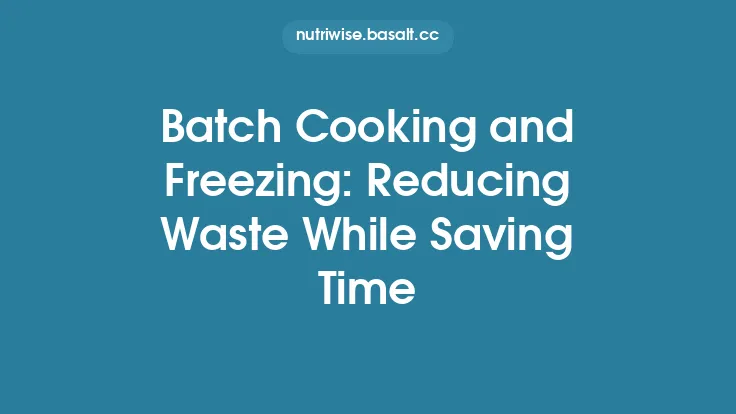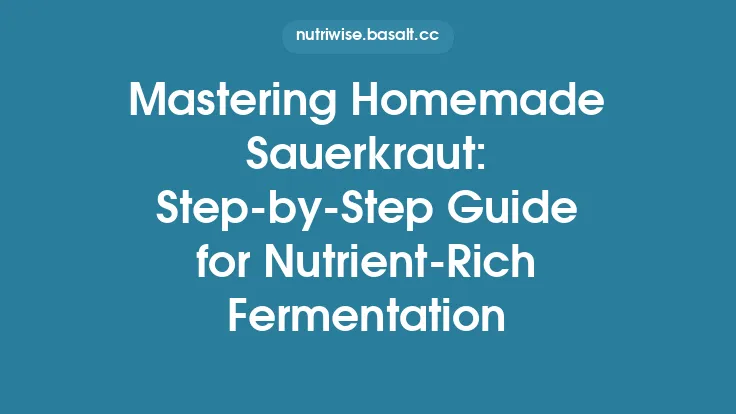Batch cooking is more than just preparing a large quantity of food in one go; it is a disciplined approach that blends culinary science, strategic planning, and efficient workflow to deliver meals that taste as fresh and vibrant as if they were made individually. When executed correctly, batch cooking can dramatically reduce weekday stress, improve nutritional consistency, and streamline grocery budgets—all while preserving the texture, flavor, and visual appeal that make home‑cooked meals satisfying. This guide walks you through the essential techniques, tools, and mind‑sets needed to master batch cooking and consistently produce high‑quality dishes.
1. Strategic Planning: From Menu to Master List
a. Define Your Meal Framework
Start by outlining the week’s meals in categories—protein‑centric dishes, grain‑based sides, vegetable medleys, and sauces. This framework helps you balance macronutrients, avoid redundancy, and ensure a varied palate.
b. Reverse‑Engineer Recipes
Select recipes that share common ingredients or cooking methods. For example, a roasted chicken, a vegetable medley, and a quinoa pilaf can all be cooked on the same sheet pan at 400 °F, saving oven space and time.
c. Create a Master Shopping List
Consolidate all ingredients into a single list, grouping items by store section (produce, bulk, meat, pantry). Use a spreadsheet or a meal‑planning app to calculate total quantities, then round up to the nearest standard package size to minimize waste.
2. Ingredient Preparation: Consistency Starts Before Cooking
a. Uniform Cutting Techniques
Cutting vegetables to a consistent size ensures even cooking. For root vegetables, aim for ½‑inch cubes; for leafy greens, a rough chop of 1‑inch strips works well. Uniformity reduces the risk of over‑ or under‑cooked pieces, which can affect texture and flavor distribution.
b. Pre‑Seasoning and Marinating
Season proteins and vegetables in bulk before cooking. Use a ratio of 1 teaspoon of salt per pound of meat, and add aromatics (garlic, herbs, citrus zest) in proportion to the total weight. Marinate for at least 30 minutes (or up to 24 hours in the refrigerator) to allow flavor penetration without compromising texture.
c. Pre‑Cooking Starches
Par‑boil or partially cook grains and legumes before the main batch. For example, simmer rice for 5 minutes less than usual; it will finish cooking during the final bake, preventing mushiness.
3. Equipment Optimization: Leveraging the Right Tools
a. Sheet‑Pan Mastery
A heavy‑gauge, rimmed sheet pan distributes heat evenly, reducing hot spots that cause uneven browning. Use parchment paper or a silicone mat for easy release and cleanup.
b. Multi‑Tier Racks
When oven space is limited, invest in a multi‑tier rack system. Position the top rack for quick‑cooking items (e.g., thin fish fillets) and the bottom rack for slower‑cooking components (e.g., root vegetables).
c. Large‑Capacity Cookware
A 6‑quart Dutch oven, a 5‑liter stockpot, and a high‑wattage immersion blender are staples for batch cooking. They allow you to simmer sauces, braise meats, and puree soups without resorting to multiple smaller pots.
d. Precision Thermometers
Digital probe thermometers with alarm functions ensure proteins reach target internal temperatures (e.g., 165 °F for poultry) without overcooking. Consistent doneness is a hallmark of quality batch cooking.
4. Cooking Techniques for Uniform Quality
a. The “Staggered” Bake
Place items that require different cooking times on the same sheet pan but stagger their start times. For instance, begin roasting carrots 10 minutes before adding broccoli, which cooks faster. This method yields uniformly cooked vegetables without sacrificing oven space.
b. One‑Pot Braising
Sear proteins first to develop Maillard flavor, then deglaze the pot with broth or wine, add aromatics, and cover for a low‑and‑slow simmer. The sealed environment locks in moisture, resulting in tender meat that retains its juices across the entire batch.
c. Controlled Steam‑Baking
Introduce a pan of water to the oven during baking to create a humid environment. This technique is especially useful for breads, dumplings, and certain casseroles, preventing crusts from forming too early and ensuring even crumb structure.
d. Batch‑Sear and Finish
For items like chicken thighs or tofu cubes, sear a large batch in a hot skillet to develop a crisp exterior, then transfer to a low‑heat oven to finish cooking through. This two‑step process preserves texture while allowing you to cook large volumes efficiently.
5. Flavor Layering: Building Depth Across the Batch
1. Base Seasoning
Apply a light, even coating of salt and pepper to all components before cooking. Salt enhances the perception of other flavors and helps draw out moisture for better browning.
2. Mid‑Cook Add‑Ins
Introduce fresh herbs, citrus zest, or a splash of acid (vinegar, lemon juice) halfway through cooking. This preserves bright notes that can otherwise evaporate during long heat exposure.
3. Finish with Umami Boosters
A drizzle of soy sauce, miso paste, or a sprinkle of grated Parmesan after cooking adds a final umami punch, elevating the overall taste profile without requiring additional cooking time.
4. Balanced Sweet‑Savory
When cooking large batches, a small amount of natural sweetener (honey, maple syrup) can counterbalance acidity and saltiness, creating a harmonious flavor that remains consistent across servings.
6. Moisture Management: Preventing Dryness and Sogginess
a. The “Steam Pocket” Technique
When roasting, toss vegetables with a thin coating of oil and a pinch of salt, then spread them in a single layer. Overcrowding traps steam, leading to soggy results. If you must crowd the pan, give the vegetables a quick 5‑minute high‑heat blast before reducing the temperature to finish cooking.
b. Sauce Integration
For dishes that will be stored, incorporate a modest amount of sauce or broth during cooking (approximately 10 % of the total volume). This internal moisture reservoir helps maintain juiciness when reheated, without making the dish overly soupy.
c. Protein Resting
Allow cooked proteins to rest for 5‑10 minutes before cutting. Resting redistributes internal juices, preventing them from spilling out and drying the meat during portioning.
7. Scaling Recipes: From Single Servings to Bulk
1. Ratio‑Based Formulas
Convert recipes into ingredient ratios (e.g., 1 part protein, 2 parts carbohydrate, 1 part vegetable). This approach simplifies scaling up or down while preserving balance.
2. Adjusting Cooking Times
When increasing volume, cooking times do not always scale linearly. For baked goods, increase the bake time by 5‑10 % for each doubling of volume, and monitor internal temperature or doneness cues (e.g., toothpick test).
3. Equipment Capacity Checks
Ensure your cookware can accommodate the larger volume without overflow. If a pot is filled more than three‑quarters full, heat transfer becomes inefficient, leading to uneven cooking.
4. Batch‑Specific Modifications
Some ingredients behave differently in bulk. For example, spices can become muted when diluted across a larger mass; increase them by 10‑15 % to maintain flavor intensity.
8. Workflow Design: Streamlining the Process
a. “Mise en Place” at Scale
Lay out all pre‑pped ingredients in clearly labeled containers before you start cooking. Group them by cooking stage (e.g., “sauté,” “roast,” “simmer”) to minimize back‑and‑forth movement.
b. Parallel Cooking
While one component is baking, use that time to sauté another or simmer a sauce on the stovetop. Synchronizing tasks reduces total kitchen time and keeps the workflow fluid.
c. Clean‑As‑You‑Go
Adopt a “one‑pot” mindset: after transferring a component to the oven, immediately rinse the pan and set it aside for the next step. This habit prevents a mountain of dishes at the end and maintains a tidy workspace, which is essential for consistent quality.
d. Time‑Block Scheduling
Allocate specific time blocks for each stage (e.g., 15 minutes for chopping, 30 minutes for roasting, 20 minutes for simmering). Use a kitchen timer or a smartphone app to stay on track and avoid overcooking any element.
9. Quality Assurance: Checking Consistency
1. Visual Cues
Uniform color (golden‑brown edges on roasted items, consistent glaze on proteins) indicates even cooking.
2. Textural Tests
Probe vegetables with a fork; they should yield with slight resistance. For grains, a single grain should be tender but retain a distinct bite (al dente).
3. Flavor Sampling
Taste a small portion of each component before final assembly. Adjust seasoning at this stage—adding a pinch of salt, a dash of acid, or a sprinkle of fresh herbs—to ensure each batch meets the desired flavor profile.
4. Temperature Verification
Use a probe thermometer to confirm that proteins have reached safe internal temperatures (e.g., 145 °F for pork, 165 °F for poultry). Consistent temperature readings across the batch guarantee uniform doneness.
10. Troubleshooting Common Batch‑Cooking Issues
| Issue | Likely Cause | Quick Fix |
|---|---|---|
| Uneven browning | Overcrowded pan, uneven heat distribution | Spread items in a single layer; rotate the pan halfway through cooking |
| Dry proteins | Over‑cooking or insufficient moisture | Add a splash of broth or a thin glaze during the last 5 minutes of cooking |
| Soggy vegetables | Excess moisture released, trapped steam | Pat vegetables dry before seasoning; use a high‑heat blast at the start |
| Flavor dilution | Large volume dilutes spices | Increase spices by 10‑15 % and finish with a fresh herb garnish |
| Grain clumping | Insufficient water or stirring | Use the correct water‑to‑grain ratio (typically 2:1) and fluff with a fork after cooking |
11. Adapting Batch Cooking for Dietary Preferences
a. Plant‑Based Proteins
When batch‑cooking legumes, tofu, or tempeh, pre‑press tofu to remove excess water, then marinate for at least 30 minutes. This improves texture and flavor absorption, ensuring plant proteins stand up to the same quality standards as animal proteins.
b. Low‑Carb Strategies
Replace starchy sides with cauliflower rice or spiralized vegetables. Process cauliflower in a food processor to a rice‑like consistency, then sauté briefly with a touch of oil—this method preserves a light texture while allowing you to batch‑cook in the same pan used for other components.
c. Gluten‑Free Adjustments
When preparing grain‑based dishes, use gluten‑free grains (quinoa, millet, buckwheat) and ensure all sauces are thickened with cornstarch or arrowroot rather than wheat flour. Batch‑cooking these grains follows the same water‑ratio principles as traditional grains.
d. Allergy‑Safe Segregation
If cooking for multiple dietary restrictions, allocate separate cookware or use silicone dividers within a large roasting pan to prevent cross‑contamination. This practice maintains quality without compromising safety.
12. Cost Efficiency: Maximizing Value in Bulk
1. Bulk Ingredient Purchasing
Buy staples such as rice, beans, and frozen vegetables in larger quantities. The per‑unit cost drops significantly, and these items store well when kept dry and sealed.
2. Whole‑Animal Utilization
When cooking with whole chickens or large cuts of meat, use the carcass to make stock, then incorporate the stock into sauces or grain cooking water. This reduces waste and adds depth of flavor to subsequent batches.
3. Seasonal Produce Alignment
Plan batch meals around in‑season vegetables, which are cheaper and more flavorful. Adjust recipes to highlight these produce items, ensuring both cost savings and superior taste.
4. Energy Optimization
Combine cooking methods—e.g., roast vegetables while a soup simmers on the stovetop—to make the most of oven heat and stovetop energy, lowering overall utility usage.
13. Documentation and Continuous Improvement
a. Recipe Logbook
Maintain a digital or physical log of each batch, noting ingredient quantities, cooking times, temperatures, and any adjustments made. Over time, patterns emerge that help you fine‑tune processes for even better consistency.
b. Photo Records
Take before‑and‑after photos of key steps (e.g., raw vs. roasted vegetables). Visual references aid in recognizing when a batch deviates from the ideal appearance, prompting corrective action.
c. Feedback Loop
If you’re cooking for a household, solicit brief feedback on texture, flavor, and overall satisfaction after each week’s meals. Use this data to tweak seasoning levels, cooking times, or ingredient ratios for the next batch.
d. Periodic Review
Every month, review your logbook and identify any recurring issues (e.g., consistently over‑cooked grains). Adjust your technique or equipment accordingly—perhaps by reducing oven temperature by 10 °F or increasing liquid for grain cooking.
By integrating meticulous planning, precise ingredient handling, optimized equipment use, and systematic quality checks, batch cooking transforms from a time‑saving shortcut into a reliable culinary system. The techniques outlined above empower you to produce meals that retain the freshness, flavor, and texture of made‑to‑order dishes—every single time you pull a batch from the oven or pot. Embrace the process, iterate based on your observations, and soon you’ll find that consistent, high‑quality home‑cooked meals become the effortless norm rather than the exception.





